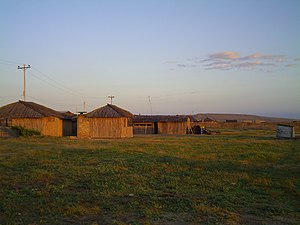Ranchería

The Spanish wordranchería,orrancherío,refers to a small, rural settlement. In the Americas the term was applied tonativevillages orbunkhouses.[1][2]Anglo-Americansadopted the term with both these meanings, usually to designate the residential area of aranchoin theAmerican Southwest,housing aboriginalranch handsand their families. The term is still used in other parts ofSpanish America;for example, theWayuutribes in northernColombiacall their villagesrancherías.
TheColumbia Encyclopediadescribes it as:
- a type of communal settlement formerly characteristic of theYaqui IndiansofSonora,TepehuanesofDurango,Mexico, and of various small Native American groups of theSouthwestern U.S.,especially inCalifornia.These clusters of dwellings were less permanent than thepueblos(see Pueblo) but more so than the camps of the migratory Native Americans.[3]
The term could be applied to the settlements of theCalifornia Mission Indiansbeyond theSpanish missions,such asMaugnaof theTongvapeople.
History
[edit]InCalifornia,the term refers to a total of 59 Indian settlements established by theU.S. government,54 of them between 1906 and 1934, for the survivors of the aboriginal population.San Diego State Universitymaintains a reference titledCalifornia Indians and Their Reservations: An Online Dictionary.It says:
The Spanish term for small Indian settlements. Rancherías are a particular California institution. A small area of land was set aside around an Indian settlement to create a ranchería. Some rancherías developed from small communities of Indians formed on the outskirts of American settlements who were fleeing Americans or avoiding removal to the reservations. […] With the passage of Public Law 83-280 in the mid-1950s, terminating federal supervision and control over California tribes, some 40 rancherías lost the right to certain federal programs, and their lands no longer had the protection of federal status. In 1983, a lawsuit resulted in restoring federal recognition to 17 rancherías, with others still waiting for the reversal of theirtermination.[4]
The word migrated north with the49ersto theFraser Canyon Gold Rushin an adapted form, "rancherie".It survives inBritish Columbiaas a somewhat archaic but still commonly used word, in rural areas and small towns, as well as in generalFirst NationsEnglish usage, meaning the residential area of anIndian reserve.It especially means the historical residential area, as opposed to newer subdivisions. It was further extended to refer to other non-white residential communities, such as theKanaka Rancheriein earlyVancouver,British Columbia,which came to house the city'sKanaka(Hawaiian) residents. In an even more truncated form,the Ranchewas used to refer to theTlingitportion ofSitka, Alaska.
See also
[edit]References
[edit]- ^Aristos: Diccionario ilustrado de la lengua española.Barcelona: Ramón Sopena. 1982. pp.516.ISBN84-303-0948-9.
Ranchería:Collection of rustic homes or huts which form a sort of settlement.
- ^Real Academia Española (2001)."Diccionario de la lengua española: Vigésima segunda edición".Archivedfrom the original on 10 November 2015.Retrieved14 December2010.
Ranchería:Collection of huts which form a sort of settlement.Rancherío:Argentina, Chile and Uruguay.Disorganized and squalid collection of precarious homes in rural areas.
- ^Rancheria.Archived2005-01-11 at theWayback MachineThe Columbia Encyclopedia, Sixth Edition.2001-07 (retrieved 12 April 2009)
- ^White, Phillip.California Indians and Their Reservations: An Online Dictionary.San Diego State University Library. Rancheria.Archivedfrom the original on 2 December 2021.Retrieved30 September2019.
